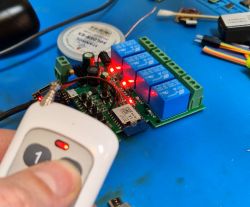FAQ
TL;DR: 24 W at 12 V draws 2 A—"With these LED parameters, the current drawn is 2A"—so a reed alone won’t do; switch the LEDs with a relay. This FAQ guides DIY cabinet-lighting choices and wiring to avoid undersized contacts. [Elektroda, Grzegorz740, post #19887535]
Why it matters: It helps DIYers pick the correct door detector and switch 12 V cabinet LEDs safely without burning contacts.
Quick Facts
- Satel K1 reed: 20 V max, 0.02 A; suited only for small indicator LEDs. [Elektroda, gkwiatkowski, post #19887362]
- A 24 W, 12 V LED load draws 2 A; size your switch or relay for that. [Elektroda, Grzegorz740, post #19887535]
- A “fridge” door switch closes on door-open and handles typical cabinet currents. [Elektroda, juan cabrillo, post #19887521]
- Many budget furniture door switches/sensors are rated up to approx. 2 A. [Elektroda, homo_sapiens, post #19887921]
- If using a reed, let it drive a relay to switch the LED current safely. [Elektroda, gkwiatkowski, post #19887362]
How do I light a 12 V, 24 W LED strip when the cabinet opens?
Switch the 2 A load with a relay controlled by your door sensor. A bare reed switch cannot carry 2 A. Select a relay with contacts rated for at least your LED current and voltage. Wire the relay so the LEDs receive power only when the door opens. This approach protects the reed and ensures reliable switching. [Elektroda, Grzegorz740, post #19887535]
Can a Satel K1 reed switch power my LEDs directly?
No. Satel K1 is rated 20 V and 0.02 A, suitable only for tiny signal LEDs. Use it as a control input instead. Drive a relay with the K1, and let the relay contacts switch the 12 V LED power. That keeps current off the delicate reed contacts. [Elektroda, gkwiatkowski, post #19887362]
What switch should I use if I want simple, direct wiring?
Use a mechanical door-activated “fridge” switch. "A 'fridge' switch would be best." It closes when the door opens and has adequate current capacity for cabinet lighting. This avoids overstressing a small reed switch. Choose a model with contacts rated for your LED load. [Elektroda, juan cabrillo, post #19887521]
Are off-the-shelf furniture door sensors enough for a 2 A load?
Often yes, but confirm the rating. Many reasonably priced units handle up to about 2 A. Check the label or datasheet before buying. Mechanical door switches and electronic LED DOOR 12 V modules are common options. Match the current rating to your 12 V LED strip’s draw. [Elektroda, homo_sapiens, post #19887921]
How do I wire a reed switch with a relay for 24 W at 12 V?
Typical wiring:
- Put the reed switch in series with the relay coil supply.
- Use the relay’s contacts to switch 12 V to the LED strip.
- Pick relay contacts rated for at least 2 A at 12 V. [Elektroda, Grzegorz740, post #19887535]
Will a 12 V PIR motion sensor work inside a cabinet?
Yes. A compact 12 V PIR module can detect door opening motion and switch your LEDs. Select a PIR specified for 12 V operation and install it where it sees the intended area. This removes the need for a mechanical door switch. [Elektroda, bhtom, post #19887569]
My switch is NC and the light stays on when the door is closed—what happened?
You used an NC device, which closes contacts when the door is closed. That feeds the LEDs all the time with the door shut. Use an NO device for door-open lighting, or change the control logic. This is a common wiring pitfall. [Elektroda, alster1, post #19887615]
How can I invert NC to NO without rewiring the light?
Add a relay to invert the logic. Drive the relay coil from the NC switch. Wire the relay contacts so power reaches the LEDs only when the door opens. "Well what is the problem of adding a relay?" [Elektroda, sosarek, post #19887620]
Can two magnets fix a reed switch that triggers in the wrong state?
Yes. Place a second magnet behind the reed so magnetic fields cancel when the door is closed. The reed then stays open with the door shut and closes only when the door magnet moves away. Adjust positions for reliable operation. [Elektroda, janek_wro, post #19887634]
I don’t want to DIY—what ready-made options can I use?
Use a prebuilt LED cabinet/wardrobe light kit, such as IKEA Norrfly. A ready-made, tested product saves time and money versus building the switching from scratch. Confirm it fits your cabinet and brightness needs. [Elektroda, rgb, post #19887523]
What current should I budget for a 24 W, 12 V LED strip?
Plan for 2 A. That is 24 W divided by 12 V. Choose switches or relays and wiring that can handle at least this current. This ensures safe and reliable operation when the cabinet opens. [Elektroda, Grzegorz740, post #19887535]
I only need a tiny indicator—can I skip the relay?
Yes. A K1-class reed can drive only small indicator LEDs, not lighting strips. If you only need a couple of tiny LEDs, you can power them directly. For anything larger, use the reed to control a relay that feeds the LEDs. [Elektroda, gkwiatkowski, post #19887362]
Where can I buy a proper cabinet door switch?
Browse door switches at major distributors, such as TME’s “door switches” category. You can choose form factor and ratings to match your cabinet and LED load. Verify current and voltage specs before buying. [Elektroda, alster1, post #19887948]
Mechanical vs electronic door switch—what should I pick?
Both are viable. Mechanical contact switches and electronic no-contact LED DOOR 12 V sensors are common. Many budget options are rated up to 2 A. Pick the style you prefer, but ensure its current rating matches your 12 V LED load. [Elektroda, homo_sapiens, post #19887921]







